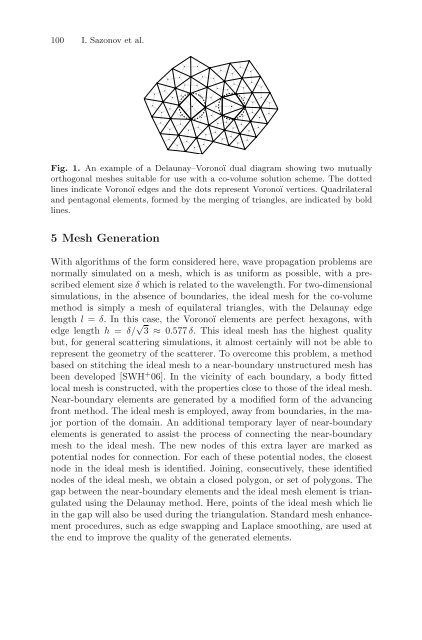Partial Differential Equations - Modelling and ... - ResearchGate
Partial Differential Equations - Modelling and ... - ResearchGate
Partial Differential Equations - Modelling and ... - ResearchGate
Create successful ePaper yourself
Turn your PDF publications into a flip-book with our unique Google optimized e-Paper software.
100 I. Sazonov et al.<br />
Fig. 1. An example of a Delaunay–Voronoï dual diagram showing two mutually<br />
orthogonal meshes suitable for use with a co-volume solution scheme. The dotted<br />
lines indicate Voronoï edges <strong>and</strong> the dots represent Voronoï vertices. Quadrilateral<br />
<strong>and</strong> pentagonal elements, formed by the merging of triangles, are indicated by bold<br />
lines.<br />
5 Mesh Generation<br />
With algorithms of the form considered here, wave propagation problems are<br />
normally simulated on a mesh, which is as uniform as possible, with a prescribed<br />
element size δ which is related to the wavelength. For two-dimensional<br />
simulations, in the absence of boundaries, the ideal mesh for the co-volume<br />
method is simply a mesh of equilateral triangles, with the Delaunay edge<br />
length l = δ. In this case, the Voronoï elements are perfect hexagons, with<br />
edge length h = δ/ √ 3 ≈ 0.577 δ. This ideal mesh has the highest quality<br />
but, for general scattering simulations, it almost certainly will not be able to<br />
represent the geometry of the scatterer. To overcome this problem, a method<br />
based on stitching the ideal mesh to a near-boundary unstructured mesh has<br />
been developed [SWH + 06]. In the vicinity of each boundary, a body fitted<br />
local mesh is constructed, with the properties close to those of the ideal mesh.<br />
Near-boundary elements are generated by a modified form of the advancing<br />
front method. The ideal mesh is employed, away from boundaries, in the major<br />
portion of the domain. An additional temporary layer of near-boundary<br />
elements is generated to assist the process of connecting the near-boundary<br />
mesh to the ideal mesh. The new nodes of this extra layer are marked as<br />
potential nodes for connection. For each of these potential nodes, the closest<br />
node in the ideal mesh is identified. Joining, consecutively, these identified<br />
nodes of the ideal mesh, we obtain a closed polygon, or set of polygons. The<br />
gap between the near-boundary elements <strong>and</strong> the ideal mesh element is triangulated<br />
using the Delaunay method. Here, points of the ideal mesh which lie<br />
in the gap will also be used during the triangulation. St<strong>and</strong>ard mesh enhancement<br />
procedures, such as edge swapping <strong>and</strong> Laplace smoothing, are used at<br />
the end to improve the quality of the generated elements.
















